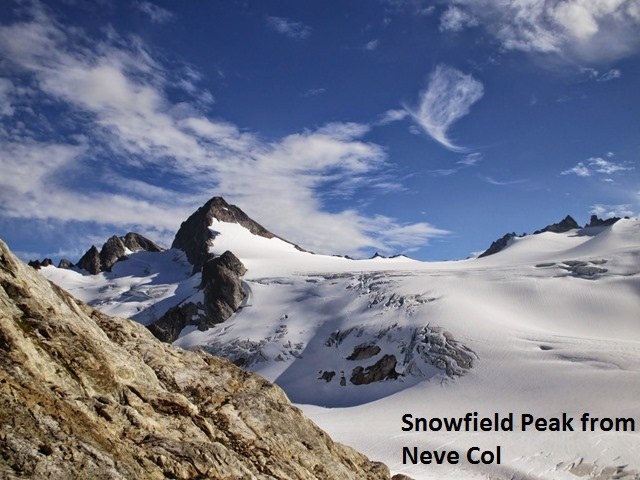
Snowfield Peak, North Cascades - July 12
[Leader]
I'm writing to report a minor injury that occurred on my Snowfield Peak climb this past weekend 7/11-7/13. This was my mentored glacier climb lead.
On Saturday, 7/12, our team of 6 climbed from our camp in the Colonial Glacier Basin up to the Neve col, where we had a break and were getting crampons and harnesses on, and roping up into rope teams. This was at about 5:15am.
One of our basic climbers, while moving around the snow-free camp there at the col, stumbled and fell, hitting his knee against a rock. The rock punctured through his climbing pants, and gashed a 3/4" inch wound about an inch and half below his knee. It looked like mainly a thick flap of skin was out of place.
The wound was not bleeding much, but looked fairly deep and there was a potential for rock particles to be embedded in the wound. The injured climber was quite shaken up and emotional, after all of his work getting to that point in the climb.
At the time of the injury, we had only been climbing for one hour, and then we had been on break for about 15 minutes ass we were getting roped up, etc. so fatigue level was low.
I and the co-leader (Wilderness First Responder certified), flushed the wound with filtered water and a syringe several times to clean it. We then covered the wound with pads, gauze, and an elastic bandage to hold it all together. The injured climber also took four ibuprofen tablets for pain.
After discussion with the injured climber, I recommended, and he agreed, that he should return to camp and not attempt the summit.
I made this recommendation due to his 1) general nervousness, 2) hesitance with some climbing skills, and 3) the concern that the wound might potentially be more serious than it appeared and further impact his ability to function well as a team member.
The injured climber also thought that it was best if he return so as to not hold the team back, and to collect himself and tend to the wound.
After a further break of about 30 minutes to let his nerves calm down, we watched the injured climber descend 600ft elevation on moderate to gentle snow slopes, arriving back to camp in the basin. He spent the day resting, eating and drinking. The team continued on to the summit.
When our climbing party returned to camp at the end of the day, the injured climber was doing fine. The wound was painful, but not bleeding through the thick bandages.
On Sunday 7/13, the group to the trailhead without further incident. The injured climber intends to go to urgent care today 7/14, to have them tend the wound.
I followed up with the injured climber. He had been to urgent care, that it was only a surface wound, should heal quickly.
[Summary]
This incident was the result of just a misstep, perhaps lack of attention to his feet, or the newness of wearing crampons. Thankfully the wound was not more serious. It was a good lesson for whole team in the seriousness of cautiousness while climbing, and also in making safe decisions as individuals and as a team.
Add a comment
Log in to add comments.Seems like you should not have sent an injured member back alone, even if you could see them all they way to camp.
 David Shema
David Shema